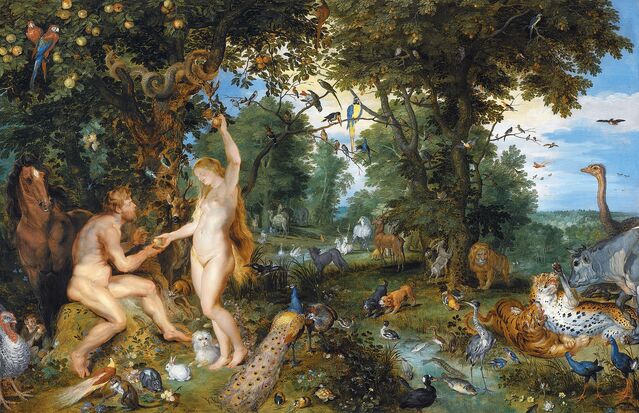Sex
About Eve
Parental investment as captured in the Bible.
Posted April 16, 2021 Reviewed by Kaja Perina

Almost 50 years ago, on the first day of January in 1972, a century after Charles Darwin published his double volume on Sexual Selection and the Descent of Man, Robert Trivers’ classic paper on “Parental Investment and Sexual Selection” went to press. Trivers defined parental investment as time and effort devoted to an offspring that raises its chances to survive and reproduce. And he drew this simple conclusion: “What governs the operation of sexual selection is the relative parental investment of the sexes in their offspring.”
In the vast majority of species, a male’s contribution to the survival and reproduction of his offspring is limited to his sex cells. Those males compete for mates. Then they tend to guard them. Homo sapiens males run the gamut of parental investment. Men across cultures offer direct care and material resources: they feed, carry, defend, and pass inheritances on to their children. But they have the option, like most other males, of limiting their parental investment to the production of sperm. And their women are often guarded.
So it goes in the Bible. In Genesis and the books that come after, women are veiled (“Your eyes are doves behind your veil”—Song of Solomon 4:3); they’re looked over by castrated men (“The king’s eunuch is in charge of the women”—Esther 2:3); they’re covered in fig leaves or animal skins (Genesis 3:7, 20). And they’re mentioned without being named.
Most of the women in Genesis with names are either the wives or concubines of named men. They’re the mothers of sons. But most daughters are anonymous. Except when they’re raped.
Abraham had 8 sons, by 3 named women—Hagar, Sarah and Ketu’rah; Sarah’s son Isaac had twin sons by his wife Rebecca; Rebecca’s son Jacob had 4 sons by his concubines Bilhah and Zilpah, and another 8 sons by Rachel and Leah, his wives. All of those sons were named; but only one daughter was. “Now Dinah was the daughter of Leah, whom she had borne to Jacob, went out to visit the women of the land; and when Shechem the son of Hamor the Hivite, the prince of the land, saw her, he seized her and lay with her and humbled her.” Afterwards, Hamor did the right thing and asked for her hand. But Jacob was mad. His sons told Shechem and his father to go circumcise themselves. They did, but the upshot was unpleasant.
“On the third day, when they were sore, two of the sons of Jacob, Simeon and Levi, Dinah’s brothers, took their swords and came upon the city unawares, and killed all the males. They slew Hamor and his son Shechem with the sword, and took Dinah out of Shechem’s house” (Genesis 34:1-2, 25-26).
Something like that would happen again to David and Absalom. On the order of a dozen generations after Jacob and his sons (Matthew 1:17), the story played out again. David had children by more than one woman. He was married to Ahin’oam, to Ab’igail, to Haggith, to Elgah, to Abi’tal, to Michal—a daughter of Saul, to Ma’acah the king of Geshur’s daughter, and to Bathsheba—Uriah the Hittite’s wife; others were never identified: “And David took more concubines and wives from Jerusalem, after he came from Hebron; and more sons and daughters were born” (2 Samuel 5:13). But many sons were named. There were Amnon, and Daniel, and Ab’salom, and Adoni’jah, and Shephati’ah, and Ith’ream, and Shim’ea, and Shobab, and Nathan, and Solomon, and Ibhar, and Elishua, and Eliphelet, and Nogah, and Nepheg, and Japhi’a, and Elish’ama, and Eli’ada, another Eliph’elet, and Jerimoth. And there was a daughter, Tamar.
“Now Ab’salom, David’s son, had a beautiful sister, whose name was Tamar; and after a time Amnon, David’s son, loved her. And Amnon was so tormented that he made himself ill because of his sister Tamar; for she was a virgin” (2 Samuel 13:1-2).
He raped her. Then he hated her. So Absalom killed Amon, and went to war with his father. He ended up with 3 darts in his chest.
Another 28 generations after David, and 42 generations after Abraham, Jesus of Nazareth was born. The book of Matthew traces Jesus’ descent from Abraham to Isaac to Jacob to Judah to Perez (by Tamar) to Hezron to Ram to Ammin’adab to Nashon to Salmon to Bo’az (by Rahab) to Obed (by Ruth) to Jesse to David to Solomon (by Bathsheba) to Rehobo’am to Abi’jah to Asa to Jeshosh’aphat to Joram to Uzzi’ah to Jotham to Ahaz to Hezeki’ah to Manas’she to Amos to Josi’ah to Jechoni’ah toShe-al’ti-el to Zerub’babel to Abi’ud to Eli-akim to Azor to Zadok to Achim to Eli’ud to Elea’zar to Matthan to Jacob to Joseph, the husband of Mary, of whom Jesus was born: 42 generations, remembered and written down, from the Father of Multitudes, to the Immaculate Conception. Then Joseph woke from sleep, and did as the angel of the Lord commanded him; he took his wife, but knew her not until she had borne a son (Matthew 1:16-24).
Then Jesus came into the world, in Bethlehem. The Bible names 12 of Jesus’ disciples, all of them men. It names James, Joseph, Simon and Judas as Jesus’ brothers. And Jesus’ sisters are mentioned—but none of them is given a name (Matthew 13:55-56, with Mark 6:3).
Jesus’ mother, on the other hand, is well known. Mary would be worshipped around the world for thousands of years, even though she was παρθένος, or parthenos, or a virgin. Because she had born a son.
So it goes across animal societies. In some species, Eve guards Adam. The largest of the phalaropes, Phalaropus tricolor, usually breeds in North America, then migrates south. Like a number of other shorebirds, this one is polyandrous. Females invest nothing in young, after their eggs are laid. Instead males brood the eggs until they hatch, then take care of the chicks for several weeks. Females are bigger than males, and they're more aggressive. Males swim alone along the edges of ponds, and more than one female swims after them; the dominant female stays closest, and attacks whenever another female moves in.
In other species, Adam guards Eve. Most male African elephants, Loxodonta africana, the largest of all land mammals, respond to loud, low frequency calls from females in estrous, and compete to copulate with them. When they come after her, younger males are repulsed, with a loud, pulsated roar. Older, more vigorous and healthy males are solicited, on the other hand. Afterwards, they become guarders. He stays close to her, and she stays close to him.
Monogamous couples are less dimorphic. Neither partner struggles to guard the other. Or would be, if we could ask them, without a name.
References
Trivers, Robert. 1972. Parental investment and sexual selection. In B. Campbell, ed., Sexual Selection and the Descent of Man 1871-1971, pp. 136-179. Chicago: Aldine.
Trivers, Robert. 1985. Social Evolution. Menlo Park: Benjamin/Cummings.
Betzig, Laura. 2005. Politics as sex: The Old Testament case. Evolutionary Psychology, 3:326-346.
Betzig, Laura. 2020. Eusociality in humans. In Lance Workman et al., Cambridge Handbook of Evolutionary Perspectives on Human Behavior. Cambridge University Press, pp. 37-46.




